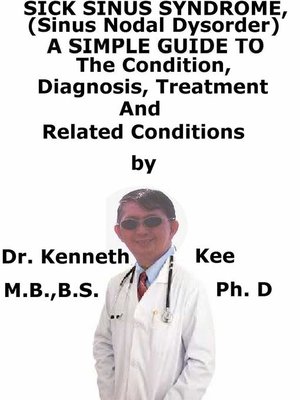Sick Sinus Syndrome, (Sinus Nodal Disorder) a Simple Guide to the Condition, Diagnosis, Treatment and Related Conditions
ebook
By Kenneth Kee

Sign up to save your library
With an OverDrive account, you can save your favorite libraries for at-a-glance information about availability. Find out more about OverDrive accounts.
Find this title in Libby, the library reading app by OverDrive.



Search for a digital library with this title
Title found at these libraries:
| Loading... |
Sick sinus syndrome is a collection of heart rhythm disorders with the sinus node, such as:1. The heartbeat rate is too slow, called sinus bradycardia2. The heartbeat pauses or stops, called sinus pauses or sinus arrest3. Episodes of a fast heart rate4. Slow heart rhythms that alternate with fast heart rhythms, called bradycardia-tachycardia or "tachy-brady syndrome"The ECG indicates sinus node dysfunction with an atrial rate that is not suitable for normal functions.Sick sinus syndrome is normally produced by idiopathic fibrosis of the sinus node.Sick sinus syndrome most often happens in people older than 50.It is often caused by scar-like injury to electrical pathways in the heart muscle tissue.In children, heart surgery on the upper chambers is a frequent cause of sick sinus syndrome.Coronary heart disease, high blood pressure, and aortic and mitral valve diseases may happen with sick sinus syndrome.Sinus bradycardia happens more often than the other forms of the disorder.Tachycardias (rapid heart rates) starting in the upper heart may be part of the syndrome:1. Atrial fibrillation,2. Atrial flutter,3. Atrial tachycardia.Periods of fast heart rates is often followed by very slow heart ratesSome medicines can worsen abnormal heart rhythms.These are digitalis, calcium channel blockers, beta-blockers, and anti-arrhythmics.Causes are:1. An intrinsic disease of the sinus node:a. Idiopathic degeneration of the sinus nodeb. Collagen vascular disease: amyloidosis, hemochromatosis,sarcoidosis.c. Familial sinoatrial node disordersd. Friedreich's ataxia, muscular dystrophy.e. Cardiomyopathies: ischemia, myocardial infarction, myocarditis, pericarditis, rheumatic heart diseasef. Surgical injury.2. Extrinsic causes:a. Hyper-kalemia, hypoxia, hypothermia, hypothyroidism, hyperthyroidism.b. Drugs - e.g., digoxinc. Toxinsd. Sleep apneaSymptomsMost of the time, no symptoms are present.Symptoms that do happen may imitate those of other disorders.1. Chest pain or angina2. Confusion3. Fainting or near-fainting4. Fatigue5. Dizziness6. Palpitations7. Shortness of breathDiagnosis:Sick sinus syndrome is diagnosed when the symptoms happen only during episodes of arrhythmia.An ECG may show abnormal heart rhythms linked to this syndrome.a. Atrial brady-arrhythmiasb.Atrial tachy-arrhythmiasc. Ventricular (escape) tachy-arrhythmia.d. Alternating bradycardias and tachycardiasAn intra-cardiac electrophysiology study (EPS) is a very specific test for this disorder.TreatmentThe patient may not require treatment if he or she does not have any symptoms.The patient may require a permanent implanted pacemaker if the symptoms are linked to bradycardia (slow heart rate).Atrial or dual-chamber pacemakers normally provide successful relief of symptoms and reduce the incidence of atrial fibrillation, thromboembolic events, heart failure and mortality, when compared with ventricular pacemakersBeta-blockers, quinidine and digoxin may be given together with a pacemaker for tachy-arrhythmias.Anticoagulation will be required for patients with atrial fibrillationA fast heart rate (tachycardia) may be treated with medicine.Occasionally, an intervention called radiofrequency ablation is done to cure tachycardia.In some cases, medicines given to control periods of fast heart rate are combined with the use of a pacemaker, which protects against periods of slow heart rate.TABLE OF CONTENTIntroductionChapter 1 Sick Sinus SyndromeChapter 2 CausesChapter 3 SymptomsChapter 4 DiagnosisChapter 5 TreatmentChapter 6 PrognosisChapter 7 Atrial FlutterChapter 8 Wolff Parkinson White SyndromeEpilogue






